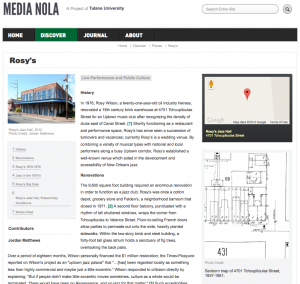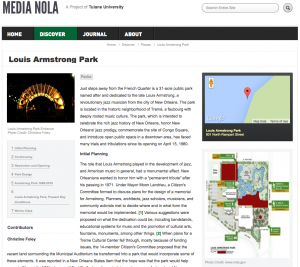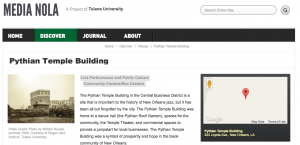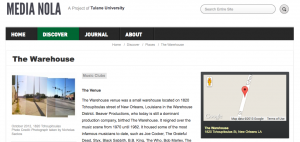Integrating Architecture into Digital and Public Humanities: Sites and Sounds + MediaNOLA
Amber N. Wiley
“Did you know @Tipitinas building has been a gym, radio station, juice bar, restaurant, & brothel? Not all at the same time, of course…”[1]
In the fall of 2012, I taught an experimental and exploratory upper-level seminar at the Tulane School of Architecture entitled “Sites and Sounds: Public History.” The course grew out of an independent, applied research project that I am conducting through the Tulane City Center, which investigates the cultural geography of New Orleans’ musical landscape. I began the seminar’s conversation on spatial and digital humanities with the above quote, tweeted by Tipitina’s — a music venue in the Uptown neighborhood of New Orleans — on August 16, 2012. Embodied in that quote of 140 characters (or less) is a nuanced and layered understanding of how the site has served the New Orleans community in multiple capacities. My students’ task in the course was to uncover the hidden histories of place at musical sites and to share them through new media techniques with a larger public audience. By presenting their research through MediaNOLA, a “portal for histories of culture and cultural production in New Orleans,” my students foregrounded and contextualized architecture as a central type of culture production.
MediaNOLA was developed by Vicki Mayer of the Tulane University Department of Communications to “encourage the preservation of collective memory by bringing together archival resources with members of the public to produce and reflect on the exceptional and ordinary people, places, and things associated with local culture.” The project combines a wiki-layout with a mapping and timeline component that enables users to pinpoint specific moments and places in the history of New Orleans and draw new meanings from those relationships. My architecture students contributed to the preservation of the collective memory of New Orleans by developing narrative histories about sites of musical production. In doing so, they demonstrated how an architecture course could fit well within the pedagogical aims of the MediaNOLA project specifically and the digital humanities more broadly.
Students in “Sites and Sounds” investigated two primary cultural forms: music and the built environment. In New Orleans, music is a significant investigative lens because it is a place-based tradition that permeates every inch of the city. Architecture is not often considered a form of cultural production, but when grounded in the theory of Henri Lefebvre, Michel de Certeau, and Dolores Hayden, my students were able to talk about the social production of space, meaning in everyday life, and the power of public engagement with history. Built and natural landscapes contain a variety of narratives, and the place-based aspects of the MediaNOLA project encouraged research that focused on a particular site, while grounding the site within a specific cultural and historical milieu.
In my course, we examined traditional and avant-garde ways to disseminate information about a community. MediaNOLA presents a twenty-first century version of the important tactics of twentieth century public history methods. One decade ago students of preservation with an inclination to public history created pamphlets, brochures, and posters to distribute and raise awareness about the buildings, landscapes, sites, and neighborhoods they were interested in preserving. Today, students using MediaNOLA are able to integrate visual materials, longer narratives, and snippets of primary sources in ways that are difficult to accomplish in academic papers. At the same time, the website builds upon the tradition of these earlier methods of public history, further advocating for the preservation of historic, overlooked, or endangered sites and creating awareness of their cultural significance.
The “Sites and Sounds: Public History” course had three main pedagogical thrusts: to serve as an introduction to cultural landscape theory, to use digital media to advance community public history, and to examine the intersections between music and the built environment in New Orleans. My learning goals for the students included nurturing an ability to set a research agenda driven by a investigative problem or question, demonstrating a working knowledge of archival research methodologies, synthesizing data in meaningful ways through narrative development and visual representation, and conducting research on emerging trends in spatial and digital media by situating MediaNOLA in a larger conversation about how new media can expand traditional pedagogies in place-based research. MediaNOLA helped me achieve those goals because I used it as both a case study and an instructional tool.
The initial two course assignments were introductory essays to ground the students in the humanities. The first was an analytic essay exploring and critiquing four spatial and digital humanities websites: Vectors, Social Explorer, HyperCities, and MediaNOLA. The next was a close reading of archival primary sources such as photographs, historical newspaper articles and advertisements, recorded oral histories, Sanborn maps, and album cover art. In these assignments, students developed informed opinions about the utility of digital humanities in a place-based research field such as architecture and cultivated skills needed to properly utilize and understand primary source archival material.
Subsequent assignments in “Sites and Sounds” dealt with refining students’ abilities to navigate the framework of the MediaNOLA website. The preliminary assignment that involved MediaNOLA was a source integration project. Many students reused the primary source that they analyzed in an earlier assignment during this first interaction with the MediaNOLA system. The goal of the project was to incorporate new sources and information into pre-existing MediaNOLA entries. One advantage to online projects such as MediaNOLA is that it iterates and grows with additional contributors, making it an increasingly useful pedagogical tool. Furthermore, students were not burdened with the task of creating a full entry from scratch but could become familiar with the system and basic HTML before developing their final projects. Their penultimate project included creating and editing a “compelling” narrative on a musical location of their choice that would eventually inform the content of their final project – their own MediaNOLA entry (See Figures 1 and 2).

Figure 1: The project on Rosy’s Jazz Hall incorporated of a variety of primary source archival material including a reproduction of a Sanborn map from the Southeastern Architectural Archives, a 1976 advertisement from the Times-Picayune, and announcements of forthcoming attractions from the Hogan Jazz Archive. http://medianola.org/discover/place/866/Rosys

Figure 2: The research on Louis Armstrong Park highlighted a controversial urban renewal project that destroyed part of the historic Tremé neighborhood. This resulted in community involvement to turn wasted space into a park to honor one of the city’s most celebrated sons. http://medianola.org/discover/place/902/Louis-Armstrong-Park
MediaNOLA features not only the physical objects that are the focus of preservation efforts, but also allows for the re-presentation, in some cases, of what has been severely altered or no longer exists. This is particularly true of the student work that highlighted the Pythian Temple Building and the Warehouse (See Figures 3 and 4).

Figure 3: The Pythian Temple Building entry included historic images the student author found in the Hogan Jazz Archive and current conditions of the unsympathetic modern alterations to the now-dilapidated building. http://medianola.org/discover/place/869/Pythian-Temple-Building-

Figure 4: The Warehouse was demolished in 1989. A panorama of the site created by the student author reflected present-day conditions. http://medianola.org/discover/place/544/The-Warehouse
MediaNOLA’s framework allows for both a historic view and contemporary view to be displayed simultaneously on the same screen, creating a powerful juxtaposition of past and present site conditions. The expansion of MediaNOLA through the New Orleans Historical mobile app adds interactivity to this dynamic by creating themed tours based on the collective research that informs the New Orleans Historical catalogue. Whereas sites of cultural production were mapped on the MediaNOLA website, the New Orleans Historical app is an on-the-ground guide to and through the spaces described on MediaNOLA. Visitors to the MediaNOLA website and users of the New Orleans Historical app grow as an informed public and can use their new knowledge to argue for the future and maintenance of New Orleans’ cultural heritage, including the significant everyday spaces of musical production.
The benefit of using MediaNOLA is manifold for students. First, it gives them a place to produce work that will be published for a public audience. Not only did my students work much harder on their MediaNOLA entries to ensure their public work was of high quality, but now they also have a web link that they can include in their resumes and portfolios. Second, trained in primary research methodologies and analysis, students combined their skills with new media tactics, transforming archives’ information from analog to digital. Furthermore, the majority of my students were unfamiliar with scholarly resources available at Tulane University prior to “Sites and Sounds;” however, through their MediaNOLA assignments students developed a familiarity with the Hogan Jazz Archive, the Amistad Research Center, the Southeastern Architectural Archive, and the Cornerstones Project of the Tulane City Center. Finally, archivists play a central role in the MediaNOLA project, and because their materials were being put to use, they interacted with students who might not have otherwise known about or used these collections.
One of the biggest obstacles my architecture students faced while working with MediaNOLA pertained to scale. They had to confront this issue when reproducing archival images to display on a web screen. Some precise details found in architectural plans and renderings became illegible in the small space allocated for images on screen, and it was difficult to enlarge and scroll through the images. Architectural presentations are highly dependent on visual aids, so the framework provided by MediaNOLA, which was mainly text-based, provided a challenge for the visually oriented architecture students.
Despite these challenges, which are likely specific to architecture students, MediaNOLA is an important tool for students across various disciplines. In fact, the website has been used in architecture, history, English, and communications classes at Tulane University. Already updated from its initial launch in 2009, MediaNOLA has improved and now includes street views with mapping of the sites, as well as a timeline on the home page that allows the visitor to slide the knob to limit or expand the search. These improvements allow for easier navigation, so that a visitor to the site can control the variables of time and place, and easily locate and identify the places he or she is exploring. As the website grows, it will continue to benefit students, scholars, and archivists across the region.
MediaNOLA encourages instructors to move beyond traditional methods of scholarship and to promote engaged learning and teaching with their students, which should be the aim of teaching in a university setting. As one student noted in his/her evaluation of the “Sites and Sounds: Public History” course “there was something exciting about being apart [sic] of [Professor Wiley’s] research [as] opposed to just hearing about existing projects.” Another student noted that one of the course’s greatest strengths was that “it was a new class, and wasn’t in typical format of lecture classes.”[2] These are important lessons to take away from bridging the gap between architectural curriculum and digital humanities. Students want to be engaged, and they want their work to be relevant to contemporary issues. The incorporation of MediaNOLA in my “Sites and Sounds: Public History” course was the addition that made the course successful in addressing those desires.
- [1]Tipitina’s Uptown. “Did you know @Tipitina’s building has been a gym, radio station, juice bar, restaurant, & brothel? Not all at the same time, of course…”, August 16, 2012. https://twitter.com/Tipitinas/status/236199144249769985.↩
- [2]Student evaluations in possession of the author.↩
